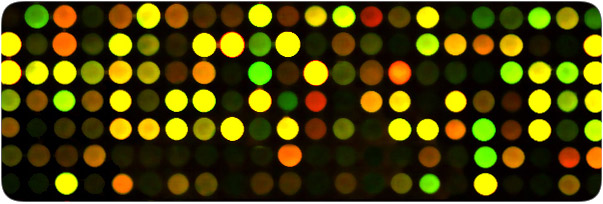 Microarrays are a technology used to determine which genes are expressed and which are repressed in two comparable populations. The two populations are grown in their varying conditions and as soon as the cells have become accustomed to their specific environment, their mRNA is extracted, made into cDNA, colored, and mixed together. This mixed cDNA solution is then poured over a pre-printed microchip. The pre-printed chip is covered in thousands, even millions of small dots that are made of specific genes of the given population. When the cDNA is poured over the chip, some of the pieces of cDNA complement the genes on the chip and stick to the dots. The chip is washed with water leaving only the dots and the cDNA that is stuck to them. From that chip, one can then determine which genes are turned on and which are were not in reference to each population by analyzing the chip using a computer while the chip sits in a black box. The analyzed data looks something like this:

The green dots are the genes activated by the first population’s cDNA and the red dots are the genes activated by the second population’s cDNA, while the yellow are genes both populations express. The intensity of the color correlates to the amount of each of the proteins being made.
At ISB:
Most of the ISB microarrays come from commercialized companies like Affymetrix and Agilent, but occasionally the facility will make slides for outside pharmaceutical companies and universities. At ISB, the microarray facility is sort of like a shared facility run by a faction of the Galitski group. They have no specific grants or projects, but work a little bit for everyone. A typical microarray takes about 16 hours to run the hybridization.
The facility generally works with mouse, human, yeast, and Halobacterium populations. They have found that model systems tend to yield more useable results because they are easier to read, but as time goes on, mammalian results are starting to become more legible. New software is constantly being designed to interpret the data and model how future genes will be affected.
The future of microarrays:
Microarrays are generally becoming less and less popular as other technologies, like DNA sequencers, become more popular. Such machines can perform feats thought improbable at the time the microarray was at its peak. The DNA sequencer has the ability to map out the entire genome of an organism, but due to the comparatively low cost and , microarrays have remained the most common way of reading mRNA expression.
|



